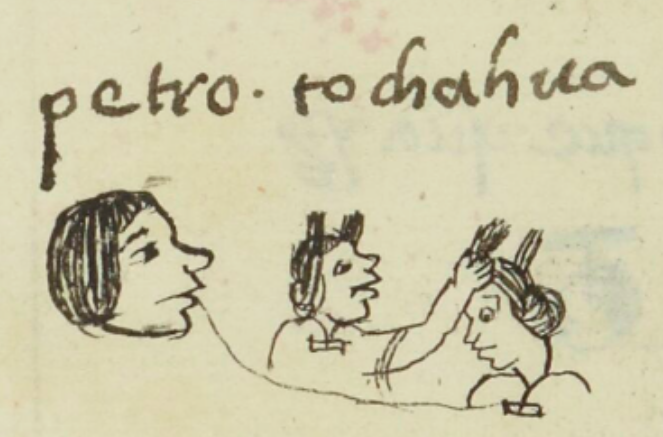Tochahua (MH537v)
This black-line drawing of the simplex glyph for the personal name Tochahua ("Our Mistress" or perhaps "Our Stepmother" attested here as a man’s name) shows a 3/4 view of two women facing each other, one grasping part of the hair of the other one. Both women have the woman's traditional huipilli blouse and their hair wound up in points above the forehead. It seem that the woman on the left is insulting the woman on the right, given that pulling hair was an insult. Note the look of surprise (wide open eye, eyebrow bent) on the face of the woman on the right.
Stephanie Wood
To pull or cut someone's hair in Nahua culture was a grave insult and cause of intense emotion. Sonya Lipsett-Rivera writes about the ritual humiliation of hair pulling in Religion in New Spain, eds. Susan Schroeder and Stafford Poole (2007), 79.
The reading of stepmother usually comes with the addition of nantli to chahua. James Lockhart suggested that, by itself, chahua- was more generally a pejorative element characterizing secondary and irregular familial relationships. It can be translated as "mistress."
Food for thought is found in a proto-Classic West Mexican ceramic sculpture with funerary associations, which shows two women touching (and possibly pulling) each other's hair. See the museum webpage discussion of what may have been happening. This was part of an exhibition at the Museum of Art and Design at Miami Dade College.
Stephanie Wood
petro. tochahua
Pedto Tochahua
Stephanie Wood
1560
Jeff Haskett-Wood
hair, cabello, pelo, pulling hair, insultando, pull, jalar, nombres de hombres

chahua, someone in an irregular relationship, a mistress, https://nahuatl.wired-humanities.org/content/chahua
chahuanan(tli), stepmother, https://nahuatl.wired-humanities.org/content/chahuanantli
Nuestra Concubina
Stephanie Wood
Matrícula de Huexotzinco, folio 537v, https://www.loc.gov/resource/gdcwdl.wdl_15282/?sp=154&st=image
This manuscript is hosted by the Library of Congress and the World Digital Library; used here with the Creative Commons, “Attribution-NonCommercial-ShareAlike 3.0 License” (CC-BY-NC-SAq 3.0).








